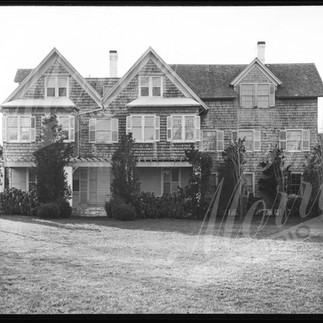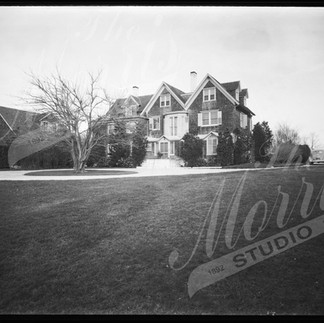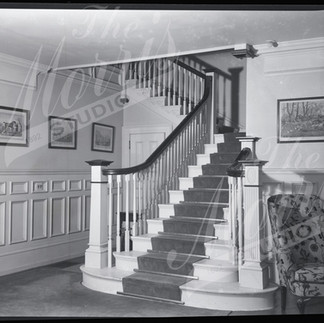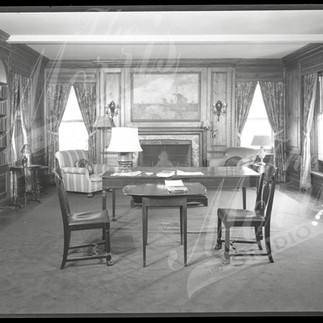Morris Studio: The Unseen Collection, Photographs of Southampton 1892-1940
- Connor Flanagan

- Jun 7, 2022
- 9 min read
Updated: Sep 1, 2022

Morris Studio: The Unseen Collection, Photographs of Southampton 1892-1940 was an exhibit we put on from August 22, 2018 until August 3, 2019 which featured many amazing photographs by the historic local photographer as well as other items and ephemera from his life. Through the year it was on display the images were frequently changed out so guests could return throughout the year and see all kinds of new images never seen before. Below is a collection of many of the images from that exhibit. Enjoy!
Images of the exhibit itself and from the opening

James Parrish House, Heathermere, Shinnecock Hills, 1932
James Parrish was an avid golfer and Heathermere, a castle-like colossus, was conveniently located next to the golf course. Grosvenor Atterbury, well known for his grand mansions, picturesque estates and informal summer cottages and a member of the Southampton summer colony, designed the house c. 1900. It has not survived.

The Henry Trevor House, Meadowmere, After a Fire in 1936
The Meadowmere Kennels near the house on Coopers Neck Lane were known at home and abroad as the place where prize dogs were bred. Henry Trevor, a sportsman who was a founder of the Shinnecock Hills Golf Club, commissioned Grosvenor Atterbury to design the house in 1910. The heavy, low-slung roof punctuated with chimneys is typical of the architect’s work.
“Villa Mille Fiori,” c. 1910
Villa Mille Fiori, the Albert Barnes Boardman estate designed by Hill & Stout, around 1910. It stood at the SW corner of Coopers Neck Lane and Great Plains Road. The house was based on Villa Medici in Rome. Mr. Boardman commissioned Polhemus & Coffin to design another home for him in 1923. He then sold Villa Mille Fiori to a law partner, Morgan O’Brien. The house was demolished in the 1960s.
The Moorings, 1937
The Moorings was originally built in 1888 for Dr. P.F. Chambers. Dr. Chambers was a friend and colleague of Dr. T.Gaillard Thomas, a leader of the Southampton summer colony. The house was enlarged and completely transformed by the colorful sportsman Walter “Scott” Cameron, who owned it from 1907 to 1922. It does not survive.
McDonnell House, 1935
The McDonnells and the Murrays were the leading families in Southampton spearheading what became known as the Irish American aristocracy. They established a compound on Wickapogue Road with several residences including this one. When Anne McDonnell married Henry Ford II in 1940, in the “wedding of the century,” a magnificent reception was held on the grounds.
Seaward Estate, Living Room, 1934
Mr. and Mrs. John T. Terry Jr. purchased their oceanfront parcel in 1890 for fifty dollars, a bargain even then. John Terry inherited a significant fortune and added to it with his banking and railroad interests. The house was enlarged by a subsequent owner and then destroyed by the 1938 hurricane.
Havens Property, 1935
Identified as a capitalist and a financier, Frank Colton Havens commissioned the house on Bay Street in Sag Harbor c. 1905. It later became the Cormaria Retreat House, a facility of the Roman Catholic Church.
L.S. Vain, c. 1930
Spencer Harrison, 1940
Wild, 1946 (Exterior) & 1940 (Interior)

Over Look, c. 1900
The cottage sits on the ocean in the “Fair Lea” compound off Gin Lane. It was built by Mr. and Mrs. Alfred Nelson in 1889 with a four story tower that evokes the windmills that marked Southampton until the late 19th century. The pergola is now gone but the cottage has been preserved.

Nighbrink
The Betts brothers, Wyllys and Frederic were among the founding members of the Southampton summer colony. They built numerous cottages and rented them to friends who they wished to join them in Southampton. Nighbrink, meaning “near the edge,” is aptly named for its location on the western edge of Lake Agawam within sight of the Atlantic. Originally a more modest cottage it got its Colonial Revival makeover from a later occupant. It was destroyed in the 1938 hurricane.

Wyndecote, c. 1900
Architect Robert Henderson Robertson designed this residence for himself in 1887. His son T. Markoe Robertson lived in the house after his father for many years. The two designed the old Rogers Memorial Library in 1895 and the original Southampton Hospital in 1911. A coachman steering a two-horse carriage can be seen emerging from the porte cochere or carriage porch. The cottage was recently restored.
Seven Ponds Inn, 1936-1941
Elliot F. Bishop’s Seven Ponds Inn was a magnet for dancers, a very popular stopping place for travelers with its 40 “modern rooms,” and for dinner guests who could enjoy a lobster dinner on Thursdays (“maids night out”) for $1.75 and dance to the society sounds of the Palm Beach Orchestra into the morning.
The Orchard, c. 1920
As the centerpiece of a condominium complex known as Whitefield today, the house was designed for James Breese at the turn of the last century by the firm of McKim, Mead & White and shows the hand of Breese’s good friend Stanford White. A partner in the firm, White’s influence on architecture in Southampton, New York City and New England was enormous. White helped paint the elaborate Renaissance-style ceiling in the Music Room of The Orchard before he was murdered in 1906. It was his last project. In 1915, England’s Country Life Magazine called it one of the twelve significant homes in America. The gardens were designed by the Olmsted Brothers, sons of the famous landscape architect Frederick Law Olmstead.
Westerly, c. 1930
The brick, Georgian-style mansion was designed in 1929 by the architectural firm Hiss & Weekes. The 25-room mansion was recently restored but not the formal, brick lined garden in the back, which was replaced.
Irving House, c. 1890 (first image), 1936-1937
Irving Terry worked as a broom maker but loved to entertain and kept expanding his home to house friends and eventually boarders. At first, he hosted them in a modest 12 rooms on the southwest corner of First Neck Lane and Hill Street. In time, it became Southampton’s most fashionable hostelry, a 100-room hotel where the cream of society sought lodgings from far and wide. Its bar and restaurant were enormously popular but by 1974 it had run its course and was demolished.
Anchorage Bar, c. 1930s
Canoe Place Inn, 1936-1937
Hampton Manor, 1941

Sag Harbor High School Band, c. 1930s

Southampton High School Band, 1935

Westhampton High School Band in Greenport, 1936

Riverhead High School Band in Greenport, 1936

High School Football Team in a Locker Room, c. 1959
Coach Herb Goldsmith, Chuck Henke (#31), Tom Porter, Jimmy Bryant, Charlie Cox, Denny McCully and Kent Mercer.

Bridgehampton School Auditorium, c. 1930s

Ron Winters Orchestra, 1936
The band members were good at multi-tasking with clarinets ready at the feet of the saxophone players and an unclaimed standing microphone near the pianist.

Mr. and Mrs. Rogers, 1937
The newlyweds were married in Jamesport.

John Nugent Family Wedding Dinner, 1936
The champagne has been poured, everyone is ready for a toast.

African American Graduates and Family, 1941
Rev. Dickenson can be seen in the middle wearing his doctor of divinity gown.

James E. Terry with a Friend, c. 1935
Mr. Terry is in costume wearing a fake, handlebar mustache and a black eye holding a revolver. He, and possibly his wife, are standing behind a makeshift bar.

Mr. and Mrs. Harris, 1937
The newlyweds are standing outside 7 Ponds Inn in Water Mill.

Conformation at Our Lady of Poland Catholic Church, 1937
The confirmation class of 1937 on the steps of Southampton’s Polish Church.

Men on Main Street, c. 1930s
The men are listening to a NY Giants game on the radio in front of Jed Licka’s piano store. It could be in 1933 when the Giants played the Washington Senators and won the National League pennant.

Harris Family Wedding, 1937
Most of the women are wearing “tilt hats” which were at the peak of their popularity in 1937.

Newly wed Mr. and Mrs. Norsic, 1942

Two Women of Fashion on a Bench, c. 1895
The highly styled costumes of the two ladies reveal their attendance at an afternoon reception. Strings of pearls and ostrich feathers, seen in the fan on the left and on the hat on the right, were popular during the Belle Époque at the end of the Victorian Era.

Family on a Country Walk, c. 1905
A woman, her two children, and maybe the woman’s father, are walking along a dirt road. Everyone is dressed in their Sunday best. The wicker perambulator, or baby carriage, is missing its parasol.

Drift Whale on the Beach, c. 1900
The history of processing drift whales in Southampton begins thousands of years ago with Native Indians. Southampton’s economy depended on them until around 1900. This photo shows local men beginning the harvest.

Old Mill House After the 1938 New England Hurricane
The Old Mill House, originally moved from Good Ground (Hampton Bays) to Gin Lane, was well established as a picturesque landmark, when it was severely damaged by the 1938 hurricane with winds reaching 130 mph, killing 682 people and destroying 57,000 homes from New Jersey to Maine. It survived and remains a much photographed attraction on Gin Lane.

Mill Hill Windmill, c. 1900
Originally located at Hill Street and Wind Mill Lane, it was moved to the Claflin estate on Montauk Highway in 1890. The estate evolved into the Tucker Mill Inn around 1920 and is now part of Stony Brook University’s Southampton Campus.

Chalet de Imer, c. 1910
Julius F. Imer built this house on John Street to remind him of his native Switzerland and called it Chalet de Imer. Mr. Imer came from a mountainous Swiss village where tornadoes were common and homeowners placed rocks on their roofs to prevent them from being torn off.

One Horse Cart with Groom and Rider, c. 1900

William Merritt Chase with Students, c. 1890
In 1891 the Shinnecock Summer School of Art, the first out-of-doors art school in the United States, opened to allow amateur and professional art students from all over the country to study plein air painting under the tutelage of artist William Merritt Chase. The 100 to 150 who studied there each summer boarded at the Art Club, which accommodated 30 women with a chaperone; local boardinghouses; or with fishermen or farmers. Wealthier students and patrons could purchase one of the dozen cottages constructed in the Art Village.

House on Gin Lane from Southampton’s Hurricane of 1938

Coast Guard Station at Mecox, c. 1920
A man in uniform poses with passengers in a Ford Model T in front of a former Life Saving Station at Mecox. By 1914 Long Island had 30 lifesaving stations that lined the South Shore and were equipped with boats to be used by local volunteers to save survivors of shipwrecks on the Atlantic Ocean. In 1915 they merged with the Coast Guard.

Southampton Hospital Truck, c. 1930

Float Portraying the Petticoat Brigade during the Revolution at the Southampton Parade, 1936

Bicycle Path on Gin Lane, c. 1900
A separate path for bicycles, at right, surrounded Lake Agawam beginning in the 1890s. Many of these buildings were destroyed during the 1938 Hurricane.

Southampton Restaurant, c. 1940
Located at the corner of Elm Street and Powell Avenue. Note the Southampton Lumber Corp. in the background.

Holden Bookseller & Stationery, c. 1935
Located at 15 Main Street.

Herberts Delicatessen, c. 1935

Fresh Air Home, c. 1935
In 1901, a small group of women, wishing to share the benefits of sun and ocean air with city-bound, physically challenged children, established a summer home in Southampton. A small building was rented to accommodate 10 children. Eventually a permanent camp was built in North Sea. The Home is one of few residential camps in the U.S. that accommodates severely as well as mildly and moderately physically challenged children.

Central Hotel and Restaurant, 1936
The Women’s Land Army, c. 1918
When the United States entered World War I in 1917, farms on the South Fork, a major agricultural region, were left seriously short-handed as local men sailed off to the front. Because it was crucial that crops be planted, nurtured and harvested while they were gone, the federal government created the Women’s Land Army to keep the farms going, and women were quick to enlist. For George Morris, it was an opportunity to document an important time in the nation’s and Southampton’s history when women were called on to perform their patriotic duty. Despite the seriousness of the circumstances, the women appear in Morris’s photographs to be embracing their role in an adventurous spirit.

Spraying a Chestnut Tree, c. 1930
Corner of Hampton Road and Main Street
Morris Family
George Morris seemed to have had inexhaustible reserves of energy. After he relocated from Sayville to Southampton, he regularly rode his bicycle back to Sayville to court Miss Henrietta Corwin, whom he soon married. Henrietta and the six Morris children--Hazel, Wilton, Nevill, Rodwick, Dorothy and Douglas--made fine photographic subjects, as did the spacious house on Elm Street, into which the family moved after living on Main Street. George and Henrietta also were lively members of local society. In 1902, a masquerade dance and supper hosted by the Morrises was hailed in the press as “the social event of the season.”

Southampton Town Football Team, c. 1896
Photographed at the Josiah Foster house the team was organized when rules for the new game were still being formulated.































































































































































